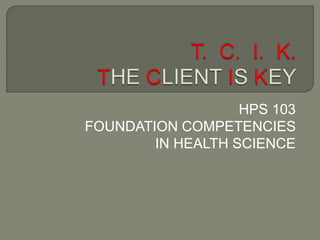
The client is key
- 1. HPS 103 FOUNDATION COMPETENCIES IN HEALTH SCIENCE
- 2. T Determine the type of stem.
- 3. C Determine who the client is.
- 4. I Determine what the issue is.
- 5. K Identify the key words.
- 7. The scenario The stem The options
- 8. This scenario provides information about a clinical health problem, and the information to consider when answering the question
- 9. The stem asks something about the scenario. Read carefully to identify specifically what is being asked.
- 10. The options are the possible answers. Read every option carefully. Reread the stem to be sure you understand what is being asked.
- 12. Read the stem. RE-read the stem with each option as a true-false statement. Eliminate the distractors and select from the remaining options. Always “GO WITH WHAT YOU KNOW.”
- 13. Read the stem. Finish the statement in your mind, and check to see if the answer is one of the options.
- 14. Your answer may or may not be one of the options, but you will be thinking along the same channels.
- 15. Re-read as four true-false statements.
- 16. Read the statement with the first option. If the statement is false, cross off the letter of that option. This is a distractor and will not be the correct answer.
- 17. If the statement is true, it may be the correct answer. Place a “+” in front of this option You won’t know if this is the correct answer until you read all four options.
- 18. If you are uncertain about an option, place a “?” in front of that option.
- 19. After reading all four options, eliminate the distractors and select from the remaining options.
- 20. If you placed an “X” in front of two options, And a “+” in front of one option, And a “?” in front of one option, SELECT the option with the “+”.
- 22. T Determine the type of stem.
- 23. There are two types of multiple choice question stems: A true-response stem. A false-response stem.
- 24. In true-response stem , the answer is true regarding the case scenario.
- 25. Key words in a true-response stem include: • Most or most appropriate • Most likely • Best judgment
- 26. Other key words include: • Initial • First • Chief • Immediate
- 27. False-response stem uses key words that ask for an answer that is NOT true regarding the case scenario.
- 28. Key words include: • Least likely • Need for further instructions or education • Lowest priority
- 29. Other key words include: • Incorrect • Unsafe • Except, not, or avoid
- 30. Determine who the client is.
- 31. The client is the person of focus.
- 32. The client may be: • The person with the health problem • A relative • A friend • A spouse or significant other • A roommate • A member of the health care team
- 33. DRILL: Practice Questions (Determine who the client is)
- 34. Determine what the issue is.
- 35. The issue is the specific subject content that the question is asking about.
- 36. The issue may include: • A medication or intravenous (IV) therapy • A side effect of a medication • An adverse or toxic effect of a medication • A treatment or a procedure • A complication of a health care problem, treatment, or procedure • A specific nursing action
- 37. DRILL: Practice questions (Determine who the client is).
- 38. Identify the key words.
- 39. Common key words: • Early or late • Best • First • Initial • Immediately • Most likely or least likely
- 40. Most appropriate or least appropriate On the day of After several days
- 41. Key words are important to identify because they will assist in eliminating the incorrect options.
- 42. Some of the key words may indicate that all of the options are correct. It will be necessary to prioritize in order to select the correct option.
- 43. Drill: Practice Question (Identify the key words).
- 44. Determine the type of stem. Determine who the client is. Determine what the issue is. Identify key words.